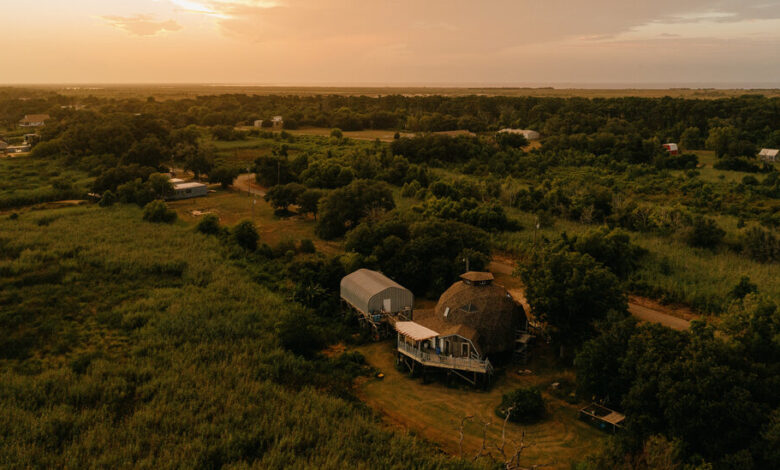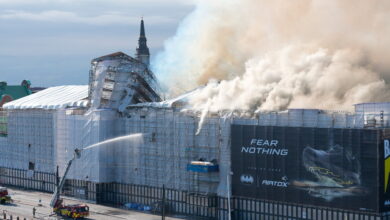As Local weather Shocks Multiply, Designers Search Holy Grail: Catastrophe-Proof Properties

[ad_1]
John duSaint, a retired software program engineer, not too long ago purchased property close to Bishop, Calif., in a rugged valley east of the Sierra Nevada. The realm is in danger for wildfires, extreme daytime warmth and excessive winds — and likewise heavy winter snowfall.
However Mr. duSaint isn’t apprehensive. He’s planning to reside in a dome.
The 29-foot construction will probably be coated with aluminum shingles that replicate warmth, and are additionally fire-resistant. As a result of the dome has much less floor space than an oblong home, it’s simpler to insulate towards warmth or chilly. And it may possibly stand up to excessive winds and heavy snowpack.
“The dome shell itself is mainly impervious,” Mr. duSaint stated.
As climate grows extra excessive, geodesic domes and different resilient residence designs are gaining new consideration from extra climate-conscious residence consumers, and the architects and builders who cater to them.
The development may start to dislodge the inertia that underlies America’s battle to adapt to local weather change: Applied sciences exist to guard properties towards extreme climate — however these improvements have been gradual to seep into mainstream homebuilding, leaving most People more and more uncovered to local weather shocks, consultants say.
Using out the storm
Within the atrium of the Smithsonian’s Nationwide Museum of American Historical past, volunteers not too long ago completed reassembling “Weatherbreak,” a geodesic dome constructed greater than 70 years in the past and briefly used as a house within the Hollywood Hills. It was avant-garde on the time: roughly a thousand aluminum struts bolted collectively right into a hemisphere, 25 ft excessive and 50 ft broad, evoking an oversize steel igloo.
The construction has gained new relevance because the Earth warms.
“We began interested by how our museum can reply to local weather change,” Abeer Saha, the curator who oversaw the dome’s reconstruction, stated. “Geodesic domes popped out as a manner that the previous can provide an answer for our housing disaster, in a manner that hasn’t actually been given sufficient consideration.”
Domes are only one instance of the innovation underway. Homes made out of metal and concrete may be extra resilient to warmth, wildfire and storms. Even conventional wood-framed properties may be constructed in ways in which greatly reduce the odds of extreme harm from hurricanes or flooding.
However the prices of added resiliency may be about 10 p.c greater than standard development. That premium, which regularly pays for itself by way of decreased restore prices after a catastrophe, nonetheless poses an issue: Most residence consumers don’t know sufficient about development to demand more durable requirements. Builders, in flip, are reluctant so as to add resilience, for concern that buyers gained’t be prepared to pay additional for options they don’t perceive.
One method to bridge that hole could be to tighten constructing codes, that are set on the state and native degree. However most locations don’t use the latest code, if they’ve any necessary constructing requirements in any respect.
Some architects and designers are responding on their very own to rising issues about disasters.
On a chunk of land that juts out within the Wareham River, close to Cape Cod, Mass., Dana Levy is watching his new fortress of a home go up. The construction will probably be constructed with insulated concrete kinds, or ICF, creating partitions that may stand up to excessive winds and flying particles, and likewise keep steady temperatures if the ability goes out — which is unlikely to occur, because of the photo voltaic panels, backup batteries and emergency generator. The roof, home windows, and doorways will probably be hurricane-resistant.
The entire level, in response to Mr. Levy, a 60-year-old retiree who labored in renewable power, is to make sure he and his spouse gained’t have to go away the subsequent time a giant storm hits.
“There’s going to be lots of people spilling out into the road looking for sparse authorities assets,” Mr. Levy stated. His aim is to journey out the storm, “and in reality invite my neighbors over.”
Mr. Levy’s new residence was designed by Illya Azaroff, a New York architect who focuses on resilient designs, with initiatives in Hawaii, Florida and the Bahamas. Mr. Azaroff stated utilizing that sort of concrete body provides 10 to 12 p.c to the price of a house. To offset that additional value, a few of his shoppers, together with Mr. Levy, decide to make their new residence smaller than deliberate — sacrificing an additional bed room, say, for a higher probability of surviving a catastrophe.
Constructing with metal
The place wildfire threat is nice, some architects are turning to metal. In Boulder, Colo., Renée del Gaudio designed a house that makes use of a metal construction and siding for what she calls an ignition-resistant shell. The decks are made out of ironwood, a fire-resistant lumber. Beneath the decks and surrounding the home is a weed barrier topped by crushed rock, to forestall the expansion of crops that might gas a hearth. A 2,500-gallon cistern may provide water for hoses in case a hearth will get too shut.
These options elevated the development prices as a lot as 10 p.c, in response to Ms. del Gaudio. That premium could possibly be lower in half by utilizing cheaper supplies, like stucco, which would offer an identical diploma of safety, she stated.
Ms. del Gaudio had motive to make use of the most effective supplies. She designed the home for her father.
However maybe no sort of resilient residence design evokes devotion fairly like geodesic domes. In 2005, Hurricane Rita devastated Pecan Island, a small neighborhood in southwest Louisiana, destroying a lot of the space’s few hundred homes.
Joel Veazey’s 2,300-square-foot dome was not considered one of them. He solely misplaced just a few shingles.
“Individuals got here to my home and apologized to me and stated: ‘We made enjoyable of you due to the way in which your home appears. We must always by no means have carried out that. This place remains to be right here, when our properties are gone,’” Mr. Veazey, a retired oil employee, stated.
Dr. Max Bégué misplaced his home close to New Orleans to Hurricane Katrina. In 2008, he constructed and moved right into a dome on the identical property, which has survived each storm since, together with Hurricane Ida.
Two options give domes their capability to resist wind. First, the domes are composed of many small triangles, which may carry extra load than different shapes. Second, the form of the dome channels wind round it, depriving that wind of a flat floor to exert drive on.
“It doesn’t blink within the wind,” Dr. Bégué, a racehorse veterinarian, stated. “It sways a little bit bit — greater than I would like it to. However I feel that’s a part of its power.”
‘On the lookout for one thing completely different’
Mr. Veazey and Dr. Bégué received their properties from Pure Areas Domes, a Minnesota firm that has seen demand bounce the previous two years, in response to Dennis Odin Johnson, who owns the corporate along with his spouse Tessa Hill. He stated he anticipated to promote 30 or 40 domes this yr, up from 20 final yr, and has needed to double his employees.
Most clients aren’t notably rich, Mr. Johnson stated, however have two issues in frequent: an consciousness of local weather threats, and an adventurous streak.
“They need one thing that’s going to final,” he stated. “However they’re on the lookout for one thing completely different.”
One in every of Mr. Johnson’s newer shoppers is Katelyn Horowitz, a 34-year-old accounting marketing consultant who’s constructing a dome in Como, Colo. She stated she was drawn by the flexibility to warmth and funky the dome’s inside extra effectively than different buildings, and the truth that they require much less materials than conventional properties.
“I like quirky,” Ms. Horowitz stated, “however I like sustainable.”
[ad_2]
Source link



